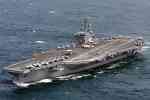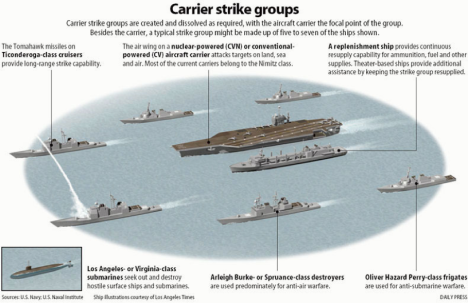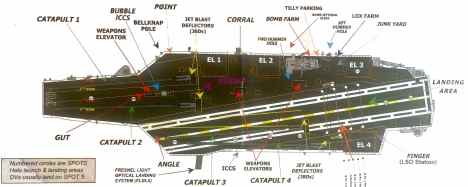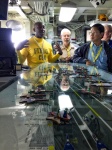The future is here it’s just distributed unevenly – Silicon Valley view of tech adoption
The threat is here it’s just distributed unevenly – A2/AD and the aircraft carrier
Sitting backwards in a plane with no windows, strapped in a 4-point harness, wearing a life preserver, head encased in a helmet, eyes covered by googles, your brain can’t process the acceleration. As the C-2 A Greyhound is hurled off an aircraft carrier into the air via a catapult, your body thrown forward in the air, until a few seconds later, hundreds of feet above the carrier now at 150 miles per hour you yell, “Holy Shxt.” And no one can hear you through the noise, helmet and ear protectors.
I just spent two days a hundred miles off the coast of Mexico aboard the U.S.S. Carl Vinson landing and taking off on the carrier deck via a small cargo plane.
Taking off and landing is a great metaphor for the carrier. It’s designed to project power – and when needed, violence.
It’s hard to spend time on a carrier and not be impressed with the Navy, and the dedicated people who man the carrier and serve their country. And of course that’s the purpose of the two-day tour. The Navy calls its program Outreach: Americas Navy. Targeting key influencers (who they call Distinguished Visitors,) the Navy hosts 900/year out to carriers off the West Coast and 500/year to carriers on the East Coast. These tours are scheduled when the carriers are offshore training, not when they are deployed on missions. I joined Pete Newell (my fellow instructor in theHacking for Defense class) and 11 other Stanford faculty from CISAC and the Hoover Institution.
I learned quite a bit about the physical layout of a carrier, how the air crew operates and how the carrier functions in context of the other ships around it (the strike group.) But the biggest learning was the realization that disruption is not just happening to companies, it’s also happening to the Navy. And that the Lean Innovation tools we’ve built to deal with disruption and create continuous innovation for large commercial organizations were equally relevant here.
The Carrier
U.S. aircraft carriers like the Vinson (there are 9 others) are designed to put the equivalent of an Air Force base anywhere on any ocean anywhere in the world. This means the U.S. can show the flag for deterrence (don’t do this or it will be a bad day) or to control some part of the sea (to protect commercial and/or military shipping, or protect a Marine amphibious force – on the way or at a place they will land); and project power (a euphemism for striking targets with bombs and cruise missiles far from home).
On an aircraft carrier there are two groups of people – the crew needed to run the carrier, called the ship’s company, and the people who fly and support the aircraft they carry, called the Air Wing. The Vinson carries ~2,800 people in the ship’s company, ~2,000 in the Air Wing and ~150 staff.
Without the Air Wing the carrier would just be another big cruise ship. The Air Wing has 72 aircraft made up of jet and propeller planes. The core of the Air Wing are the 44F/A-18 strike fighters.
The F/A-18 strike fighters are designed to do two jobs: gain air superiority by engaging other fighter planes in the air or attack targets on the ground with bombs (that’s why they have the F/A designation). Flying on missions with these strike fighters are specially modified F/A-18’s – EA-18G Growlers that carry electronic warfare jammers which electronically shut down enemy radars and surface-to-air missiles to ensure that the F/A-18s get to the target without being shot down.
Another type of plane on the carrier is the propeller-driven E-2C Hawkeyes, which is an airborne early warning plane. Think of the Hawkeyes as airborne air traffic control. Hawkeyes carry a long-range radar in a dome above the fuselage, and keep the strike group and the fighters constantly aware of incoming air threats. They can send data to the fighters and to other ships in the battle group which identifies the location of potential threats. They can also detect other ships at sea.
The other planes in the carrier’s Air Wing are 16 helicopters: 8 MH-60S Nighthawkhelicopters for logistics support, search and rescue and special warfare support; and 8 MH-60R Seahawks to locate and attack submarines and to attack Surface targets. They carry sonobuoys, dipping sonar and anti-submarine torpedoes. And last but not least, there is the plane that got us on the carrier, the C2-A Greyhound – the delivery truck for the carrier.
They carry sonobuoys, dipping sonar and anti-submarine torpedoes. And last but not least, there is the plane that got us on the carrier, the C2-A Greyhound – the delivery truck for the carrier.
You’re not alone
Carriers like the Vinson don’t go to sea by themselves. They’re part of a group of ships called the “carrier strike group.” A strike group consists of a carrier, two cruisers withTomahawk cruise missiles which can attack land targets, and two destroyers and/or frigates with Aegis surface to air missiles to defend the carrier from air attack. (In the past, the strike group was assigned an attack submarineto hunt for subs trying to kill the carrier. Today the attack subs are in such demand they are assigned by national authorities on an as-needed basis.) The strike group also includes replenishment ships that carry spare ammunition, fuel, etc. (The 150 staff on the carrier include separate staff for the strike group, Air Wing, carrier, surface warfare (cruisers with tomahawk missiles) and air defense (Aegis-armed destroyers.)
 The strike group also receives antisubmarine intelligence from P-3/P-8 anti-submarine aircraft and towed arrays on the destroyers, and additional situational awareness from imaging, Electronic Intelligence (ELINT) and radar sensors and satellites.
The strike group also receives antisubmarine intelligence from P-3/P-8 anti-submarine aircraft and towed arrays on the destroyers, and additional situational awareness from imaging, Electronic Intelligence (ELINT) and radar sensors and satellites.
Before our group flew out to the carrier, we were briefed by Vice-Admiral Mike Shoemaker. His job is aviation Type Commander (TYCOM) for all United States Navynaval aviation units (responsible for aircrew training, supply, readiness, etc.) He also wears another hat as the commander of all the Navy planes in the Pacific. It was interesting to hear that the biggest issue in keeping the airplanes ready to fight aresequestration and budget cuts. These cuts have impacted maintenance, and made spare parts hard to get. And no pay raises make it hard to retain qualified people.
Then it was time to climb into our C-2 Greyhound for the flight out to the aircraft carrier. Just like a regular passenger plane, except you put on a life vest, goggles, ear plugs, and over all that a half helmet protecting the top and back of your head while enclosing your ears in large plastic ear muffs. Then you and 25 other passengers load the plane via the rear ramp, sit facing backwards in a plane with no windows and wait to land.
On the U.S.S. Vinson
Landing on an aircraft carrier is an equally violent act. When you make an arrested landing, a tail hook on the plane traps one of the four arresting cables stretched across the deck, and you decelerate from 105 mph to zero in two seconds. When the plane hit the arresting wire on the carrier deck, it came to a dead stop in 250 feet. There was absolutely no doubt that we had landed (and a great lesson on why you were wearing head protection, goggles and strapped into your non-reclining seat with a four-point harness). As the rear ramp lowered, we were assaulted with the visual and audio cacophony of crewmen in seven different colored shirts on the deck swarming on and around F-18s, E2Cs, helicopters, etc., all with their engines running.
Captain Doug Verissimo and his executive officer Captain Eric Anduze, welcomed us to the carrier. (One of my first problems onboard was translating Navy ranks into their Army/Air Force equivalents. For example, a navy captain equals an Air Force/Army Colonel, and a rear admiral is a brigadier general, etc.)
 Then for the next two days the carrier’s public affairs officer led us on the “shock and awe” tour. In four years in the Air Force I had been stationed on four fighter bases, three of them in war zones, some with over 150 planes generating lots of sorties. But I had to grudgingly admit that watching F-18s landing on a 300-foot runway 60 feet above the water, on a pitching deck moving 30 mph at sea – one a minute – at night – was pretty impressive. And having us stand on the deck less than 50 feet away from these planes as they landed trapping the arrestor wires, and launched via a catapultwas a testament to the Navy’s PR acumen. Most of crew on the flight deck are in their late teens and maybe early 20s. (And for me, hard to believe 4 decades ago in some other life I was doing that job.) Standing on the deck on a Navy carrier, it’s impossible not to be impressed with the precision choreography of the crew and the skill of their pilots.
Then for the next two days the carrier’s public affairs officer led us on the “shock and awe” tour. In four years in the Air Force I had been stationed on four fighter bases, three of them in war zones, some with over 150 planes generating lots of sorties. But I had to grudgingly admit that watching F-18s landing on a 300-foot runway 60 feet above the water, on a pitching deck moving 30 mph at sea – one a minute – at night – was pretty impressive. And having us stand on the deck less than 50 feet away from these planes as they landed trapping the arrestor wires, and launched via a catapultwas a testament to the Navy’s PR acumen. Most of crew on the flight deck are in their late teens and maybe early 20s. (And for me, hard to believe 4 decades ago in some other life I was doing that job.) Standing on the deck on a Navy carrier, it’s impossible not to be impressed with the precision choreography of the crew and the skill of their pilots.
Our group climbed the ladders (inclined at a 68-degree angle – there are no stairs) up and down the 18 decks (floors) of the ship. We saw the hangar deck where planes were repaired, the jet engine shop, jet engine test cell, arresting cable engine room, the bridge where they steer the ship, the flag bridge (the command center for the admiral), the flight deck control and launch operations room (where the aircraft handler keeps track of all the aircraft on the flight deck and in the hangar), and the carrier air traffic control center (CATCC).
At each stop an officer or enlisted man gave us an articulate description of what equipment we were looking at and how it fit into the rest of the carrier.
(What got left out of the tour was the combat direction center (CDC), the munitions elevators, ships engines and any of the avionics maintenance shops and of course, the nuclear reactor spaces.)
During lunch and dinners, we had a chance to talk at length to the officers and enlisted men. They were smart, dedicated and proud of what they do, and frank about the obstacles they face getting their jobs done. Interestingly they all echoed Vice-Admiral Shoemaker’s observation that the biggest obstacles they face are political – sequestration and budget cuts.
Just before we left we got a briefing from the head of the Carrier Strike Group, Rear Admiral James T. Loeblein about the threats the carrier and the strike group face.
Then it was off to be catapulted back home.
It’s clear that the public affairs office has a finely tuned PR machine. So if the goal was to impress me that the Navy and carriers are well run and manned – consider it done.
However, it got me thinking… new aircraft carrier’s cost $11 billion. And we have a lot of them on order. Given the threats they are facing are they going to be viable for another 30 years? Or is the aircraft carrier obsolete?
Tomorrow’s post will offer a few days’ worth of thoughts about carriers, strike groups and how the Navy can continue to innovate with carriers and beyond.
Lessons Learned – part 1 of 2
- Our carriers are a work of art run and manned by professionals
- Lots more in part 2, in the next post…
Thanks to the crew of the U.S.S. Vinson, and Commander Todd Cimicata and Stanford for a real education about the Navy.
